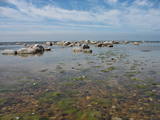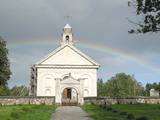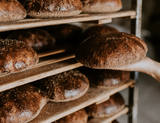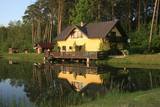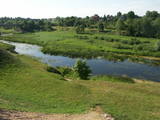| Nr | Nosaukums | Apraksts |
|---|---|---|
|
„Vitrupe - Tūja” - nozīmīga teritorija rifu aizsardzībai. Teritorija atrodas iepretim Salacgrīvas novadam, tās platība ir 3577 ha. Teritorija ietver dabas lieguma „Vidzemes akmeņainā jūrmala” jūras daļu.
|
||
|
Aizkrauklē, braucot pa Enerģētiķu ielu un nonākot Sēlijas pusē (ceļa malā nelielas „kabatiņas”) paveras viens no plašākajiem Daugavas upes baseina ieleju skatiem, atgādinot, kāda mūsu likteņupe bija pirms hidroelektrostaciju celtniecības. Redzamas upes straumes erodētā labā krasta stāvās nogāzes un tālākais ielejas posms, kas ietilpst Daugavas dabas parkā.
|
||
|
Rikavas (Baltiņu) Dievišķās Providences Romas katoļu baznīca
uzbūvēta doriešu stilā 1829. gadā par grāfa Aleksandra Rika
līdzekļiem un veltīta dievišķās providences gādībai. Baznīcā apskatāmas
Dievmātes glezna, „Svētais Antonijs”, „Kristus parādīšanāsMarijai
Magdalēnai”. Pie baznīcas ir kapsēta un muižnieku Riku dzimtas
kapliča.
|
||
|
Pēc 2005. g. orkāna atjaunotajā Randu pļavu dabas takā (ap 4 km gara) ir uzcelts un 2015. gadā atjaunots putnu vērošanas tornis, no kura pārskatāmas unikālās piekrastes pļavas ar nelielām lagūnām un niedrājiem. Piemērota vieta migrējošo putnu vērošanai. Atrodas Ziemeļvidzemes biosfēras rezervātā. |
||
|
Atrodas 0,9 km ziemeļrietumos no Dzērbenes centra. Tagadējais muižas komplekss veidojies 14. gs. celtās un 1577. g. nopostītās mūra pils vietā. Muižas pils (18. gs. beigas, klasicisma stils) savā pastāvēšanas laikā piedzīvojusi vairākkārtīgu nopostīšanu (1905. g., Pirmajā pasaules karā) un tai sekojošu atjaunotni. 19. gs. beigās tai tapa piebūve – iespaidīgs četrstūru neogotikas stila tornis. Laikā no 1927. - 1975. g. pilī darbojās lauksaimniecības skola, tagad - Dzērbenes pagasta pārvalde, Tautas nams un mūzikas skola. Pili ieskauj parks ar septiņu dīķu kaskādi. No kādreiz iespaidīgā laukakmeņu žoga saglabājušies vien pils vārtu stabi. Dažādā stāvoklī (arī avārijas) atrodas citas muižas ēkas. 2010. gadā tika veikta pils iekštelpu un ārējās fasādes restaurācija. Iepriekš piesakoties, tiek piedāvāta gida vadīta ekskursija un piedzīvojums muižā iekārtotajā spoku kambarī. |
||
|
SIA N. Bomja maiznīca „Lielezers” atrodas Limbažos. Uzņēmums dibināts 1991. gadā. Maiznīca piedāvā dažāda veida rudzu maizes, kviešu maizes un konditorejas izstrādājumus. Maiznīcas “Lielezers“ lepnums ir īsta rudzu maize un sadskābmaize, kas ceptas pēc ilgas un darbietilpīgas tehnoloģijas. Pašu dzirnavās tiek malti Latvijā audzēti rudzu un kviešu milti, bet plaucējumi tiek diennakti nogatavināti pašu darinātajos apses koka kubuliņos un raudzēti ar ieraugu. Klaipus dala un veido tikai ar rokām. Maizes ražošanu vada pieredzes bagāti maiznieka amata meistari ar palīgiem - maiznieka amata zeļļiem. Tiek piedāvāts ražotnes apmeklējums un tikko ceptas maizes degustācija. |
||
|
Atpūtas vieta "Kaupēna dzirnavas" atrodas netālu no Tērvetes, Zemgales reģionā. Viesu mājā pieejama zāle svinībām, ir dārzs ar grilu. Viesiem ir pieejama bezmaksas privātā autostāvvieta. Virtuvīte ir pilnībā nodrošināta ar traukiem un galda piederumiem, ir mikroviļņu krāsns. Turku pirts un terase. Viesu mājā nakšņošanai nodrošinātas 15 gultas vietas. Viesiem tiek piedāvāta arī brīvdienu māja "Paradīzes māja". Tā ir pilnībā aprīkota ģimenes mājiņa ar virtuvīti un 4 gultasvietām, skats uz dīķi, grils un lapene. Kvalitatīvs akas / avota dzeramais ūdens. "Egļu namiņš" - mājiņā ir 5 gultasvietas, priekštelpa, terase. Grils ar terasi, blakus dīķis, WC, dušas. Piedāvājumā arī 3 kempinga mājiņas. Katrā mājiņā 4 gultasvietas. WC un dušas tiek nodrošinātas kopējas. |
||
|
Aktīvā atpūta svaigā gaisā, dabā. Dabas taka, atpūtas vieta, grilla vietas, lapenes. Lāzera cīņas jeb Laser tag ir spēle svaigā gaisā, ģimenes vai draugu kompānijā. Iegūsiet pozitīvas emocijas un kārtīgu adrenalīna devu, spēlējot augsti tehnoloģisko spēli reālā laikā un vietā. Lāzera cīņas ir visiem labi zināmā peintbola analogs, bet atšķirīgs ar to, ka Laser taga spēlē spēlētājus-pretiniekus “neitralizē” ar drošiem un nekaitīgiem lāzera šāvieniem no lāzera-ieroča, bet pati spēlētāja “neitralizācija” notiek, kad speciāli devēji (sensori), kuri ir nostiprināti uz spēlētāja apsaites, reģistrē pretinieka lāzera-ieroča staru, kas nozīmē, ka nav ne krāsu bumbiņu, ne sāpīgi sitieni, ne zilumi. Šī koncepcija padara Laser tagu pieejamu ne tikai vīriešiem, bet arī sievietēm un bērniem. |
||
|
Esko Farm is a family business which focuses on making dairy products from their own lifestock. Farm's products include yogurt ice creams, cheeses, yogurts and so on. It's possible to take a tour around the farm, get to know the animals as well as have degustation of the farm's products. |
||
|
The Bauska Nature Park runs for several dozen kilometres along the Lielupe River and its tributaries – the Mūsa and the Mēmele. This is a protected territory. The shores of these rivers contain some of the largest dolomite cliffs in Zemgale. These are protected both as biotopes and as geological monuments. The rivers are important places for river lampreys and vimbas to spawn. Tourists will be attracted by the cultural landscape of the area, as well as the cultural monuments such as the Bauska castle, the Jumpravmuiža park, the Mežotne castle hill, Vīna Hill, the Mežotne castle, etc. The rivers are used for water tourism. |
||
|
The fisherman’s homestead that is alongside the Kolka Lutheran Church offers a look at how fish are smoked and prepared. You can taste the fish and purchase fish that were caught in the sea (mostly plaice). |
||
|
The Orthodox Church and Cloister of the Holy Spirit and the Orthodox Church of St Nicholas the Miracle Maker are found at Brīvības Street 200 in Jēkabpils. The Byzantine Church of the Holy Spirit was built between 1853 and 1886 to replace a wooden church which had been built in the latter half of the 17th century and burned down in 1773. Duke Jacob of the Duchy of Courland supplied the timber for the old church. The cloister was alongside the church. On Second Easter in 1903, the church caught on fire, and the only icon rescued was a painting of the Virgin Mary. The church suffered damage during World War I and was restored in 1933. Alongside the Church of the Holy Spirit is the oldest church in Jēkabpils – the oldest stone church in the city, which is named after St Nicholas the Miracle Maker and was erected in 1774. This is a very small church, just 17 x 19.5 m. The cloister of the Church of the Holy Spirit operates the church today, and it can be viewed from the inside. The stone fence that surrounds the complex is massive, but atypical of urban environments in Latvia.
|
||
|
This is a new farm that produces cheese and waits for groups of visitors. People can help to make cheese and taste and buy it. Lejnieki won a prize as the most orderly working farm in the Valka Administrative District. |
||
|
Atrodas Jasmuižas austrumdaļā. Dievnams celts 1815. g., bet pārbūvēts 1932. g. |
||
|
This lovely farm features lilies, peonies and other flowers, as well as a beautiful rock garden and a dendrological park that is under development. Bees from more than 100 hives produce honey. The lady of the house will take you on a tour and offer plants and honey products for sale. |
||
|
A unique farmyard that includes a full set of buildings typical of this area. The farmstead buildings reflect at least 300-400 years of Latvian nation-building development. In the area it is possible to stay in a dwelling house (2 rooms, two people each) and in the tents. Picnic places available. It is also possible to organize different events and activities. |
||
|
Biedrība "Latvijas Slieku audzētāju asociācija" tika nodibināta 2010. gada 1.septembrī ar mērķi attīstīt sliekkopību un vermikomposta ražošanu Latvijā. Pamatnodarbošanās - vermikomposta ražošana. |
||
|
This is an authentic Lettigalian farm which dates back to the early 20th century. It features a house, granary, cattle shed, sauna and smithy. Folklore groups perform here. You can celebrate the Summer Solstice, attend a St Michael’s Day market and learn ancient craftsmanship skills. Lettigalian foods are served to groups. |
||
|
The saloon is in the centre of Vecumnieki and features antique household objects as part of its interior design. Breakfast, lunch and dinner are all prepared on an open fire, making use of an ancient spirit and the cookbooks of grannies. Desserts, too, are all made from natural ingredients. Latvian cuisine: Pork with sauerkraut. Special foods: Handmade pierogi with home-cured meat. |
||
|
Krāčains Lobu upes (Loobu jõgi) posms pie Joaveski ciema, kur ~ 160 m garumā upes gultnē, tai šķērsojot Ziemeļigaunijas glintu, izveidojušās izmēros nelielas, tomēr ļoti ainaviskas un skaistas 0,5 – 1 m augstas ūdenskritumu kaskādes. 1898. g. šeit uzcēla hidroelektrostaciju, kuras atliekas ir redzamas upes labajā krastā. Iecienīta pavasara laivotāju treniņu vieta. |
||
